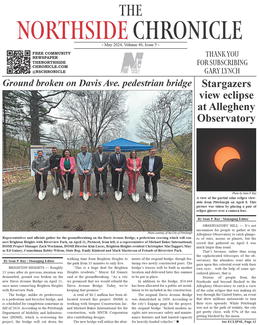
Northside German club accepting offers for painter’s historic home
Photo: The boyhood home of 19th century artist George Hetzel as it stands now, nearing condemnation. By Ashlee Green
Nineteenth-century painter George Hetzel preserved Pittsburgh’s past in his work. Now, The Teutonia Männerchor in East Deutschtown is hoping to preserve his childhood home.
By Janine Faust
Nineteenth-century artist George Hetzel sought to capture Pittsburgh’s natural landscape before it was lost to the rapid growth of industry. Now, a Northside-based organization is trying to save a part of the renowned painter’s personal past.
The Teutonia Männerchor, a private German club located in East Deutschtown, is currently accepting purchase offers for George Hetzel’s boyhood home, located at 868 Phineas St., across from the club’s hall. Hetzel was a prominent landscape artist in the late 19th century who established the Scalp Level artists’ colony near Johnstown, PA. His work was even shown at the Carnegie Institute’s first annual International Exhibition in 1896.
The Teutonia’s Hausmeister Kevin Varrato and Director Joe Brandt presided over a review of the house on Jan. 15, where they discussed its current state and how to submit an offer with 20 community members.
“It’s a fixer-upper,” Varrato noted during a slideshow of pictures of its interior.
According to a timeline written by late local historian Carol Petersen, the home was part of a double house built sometime between 1836-1844 by George Hetzel’s parents. Hetzel, who was born in 1826, lived in the double house as a child before it was sold in 1845. Petersen wrote that the double house was made in the “saltbox” form, which was “at least somewhat common in the construction of working-class housing in Allegheny [City] and other parts of the Pittsburgh area during the second quarter of the 19th century.”
A small amount of saltbox houses still exist in the Northside and the rest of Pittsburgh, Petersen noted, “as a result of development and demolition.”
Over the next century, the house was passed down through several families before it was sold to The Teutonia for $10,000 in June 2002.
The Teutonia has been using the building for storage since acquiring it, according to Varrato.
“It’s a fairly small piece of property,” he said. “Remarkably, for its age and everything, there’s maybe two or three weak spots in the whole structure.”
Varrato explained that the club cannot afford to maintain the house on its own. The City condemned the building in July after the chimney broke off, Varrato said, missing the house but leaving behind a gaping hole.

He said the Teutonia was able to have the condemnation postponed until April 2020* by agreeing to stabilize the building in the meantime, and are now searching for a buyer willing to purchase it “as-is.”
Varrato and Brandt said a conservative estimate for restoring the house lies between $175,000 to $250,000. Necessary work includes stripping down and redoing the 190-year-old unburnt brick as well as installing utilities. However, Varrato said there may be hidden costs that are not obvious yet.
“Until you start ripping the drywall down and the plaster down and getting to the actual bones of the building, the cost could be lower or higher,” he said.
At the moment there is no set price for selling the house. Brandt said interested parties need to submit written proposals to him, Varrato, President John Erskine or Finance Secretary Chris Jordheim by Jan. 31 at 5 p.m. Brandt and Varrato can be reached for more information at letsgopitt@aol.com or teutoniahausmeister@gmail.com*, respectively.
Representatives from the Community Alliance of Spring Garden East Deutschtown (CASGED) were also present at the review. CASGED is interested in ensuring the historic building is not turned into an empty lot or office building, according to vice president Tye Silverthorne. He explained that while CASGED also cannot financially support renovations, the nonprofit is willing to help find sources of funding.
“There’s tons of important buildings in this neighborhood being torn down, and this is one of the few that are left,” Silverthorne said.
Varrato said plenty of members of The Teutonia hope to see the building saved.
“Me personally, I’d like to see whatever’s best for the community,” Varrato said. “There’s too much history gone to the wayside that could have been saved but has been destroyed.”
Related posts:
Northside German Club crowns new Radish King
On the Scene: Alliance of Germanic Societies Luncheon
Roaming Social Club visits Teutonia Männerchor
*1/28/2020: Updates were made to this article to correct dates and relevant email addresses.











